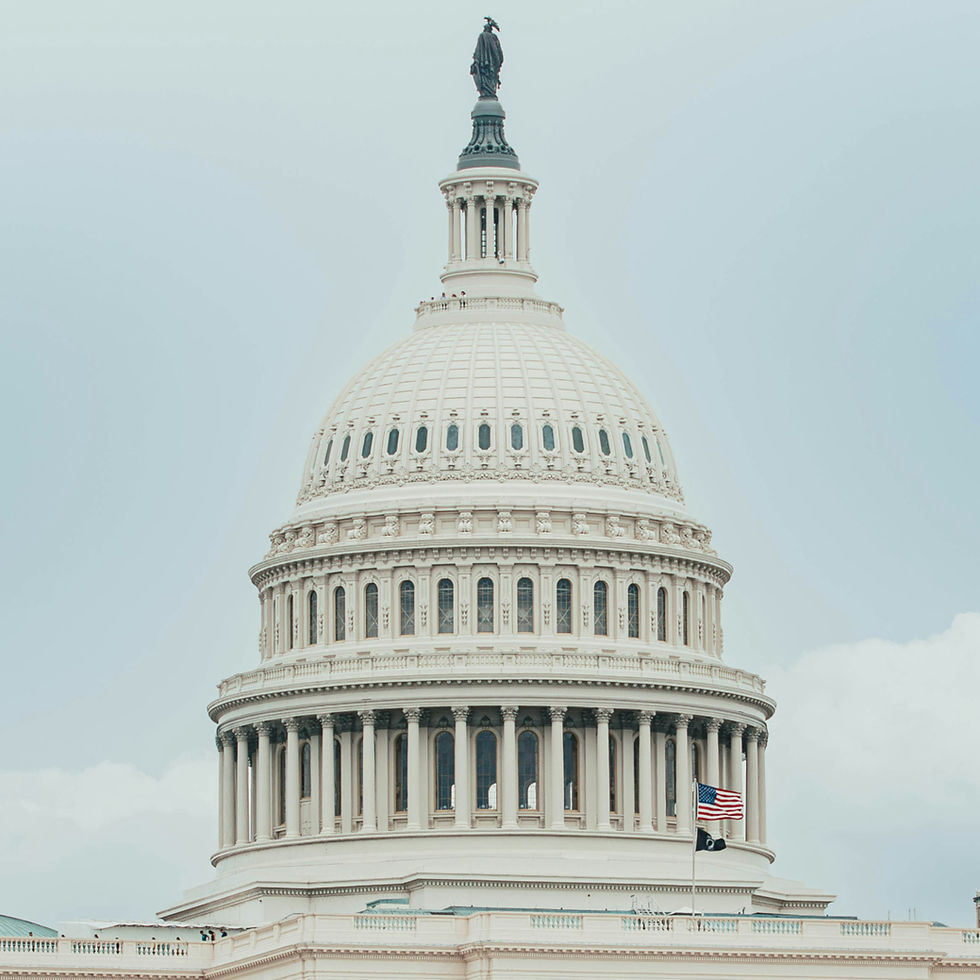The political economy of nonbank escape from SIFI designation
- Macroprudential Policy

- Aug 16
- 4 min read
Updated: Aug 18

Nonbanks evade SIFI rules through legal loopholes, political influence, and regulatory capture, despite posing risks comparable to big banks.
Without reforms, the next crisis may originate in the unregulated shadows of finance.
Systemic Risks Stemming from Nonbanks
Nonbanks—including asset managers, private equity firms, insurers, and fintech companies—now control over half of global financial assets but remain largely outside the stringent regulations applied to banks. Their activities create systemic risks through several channels:
(A) Liquidity Mismatches & Run Risks
Asset Managers (e.g., BlackRock, Vanguard):
Open-End Funds/ETFs: Promise daily liquidity while holding illiquid assets (e.g., corporate bonds, emerging market debt).
Example: During March 2020, the Fed intervened to stabilize $3.6T in money market funds after mass redemptions.
Private Equity (e.g., Blackstone, KKR):
Lock up investor capital for years but rely on short-term debt ("leveraged loans") to finance acquisitions.
(B) Hidden Leverage & Contagion
Hedge Funds (e.g., Citadel, Bridgewater):
Use derivatives and repo markets to amplify bets (e.g., Archegos’ $100B exposure collapse in 2021).
Insurers (e.g., Berkshire Hathaway, AIG pre-2008):
Invest premiums in risky assets (e.g., AIG’s $500B derivatives book in 2008).
(C) Interconnectedness with Banks
Shadow Banking’s Dependency:
Nonbanks borrow $5T+ from banks via repo markets and credit lines.
Example: In 2023, Credit Suisse’s collapse threatened private equity firms reliant on its lending.
"Too Big to Fail" Links:
BlackRock is the top shareholder in JPMorgan, BofA, and Citigroup, creating feedback loops.
Definition: What is a SIFI?
A Systemically Important Financial Institution (SIFI) is a firm whose failure could trigger a financial crisis due to its size, complexity, interconnectedness, or critical functions. SIFIs are subject to stricter regulations (e.g., higher capital buffers, stress tests) under frameworks like:
U.S. Dodd-Frank Act (FSOC designations)
Financial Stability Board (FSB) Global SIFI list
Basel Committee standards
Designated SIFIs (2023):
Banks: JPMorgan Chase, Bank of America, HSBC
Nonbanks (rare): AIG (2013–2017), Prudential Financial (2013–2018)
Undesignated Mega-Nonbanks (2023):
Asset Managers: BlackRock ($9.1T AUM), Vanguard ($7.2T AUM)
Private Equity: Blackstone ($1T AUM), Apollo Global
Insurers: Berkshire Hathaway ($1T assets), MetLife
Fintech: PayPal, Visa/Mastercard
Size Comparison: Nonbanks vs. Banks (2023)
Institution | Type | Assets/AUM ($T) | SIFI Status |
JPMorgan Chase | Bank | $3.7 | Yes (G-SIB) |
BlackRock | Asset Mgmt | $9.1 | No |
Bank of America | Bank | $3.1 | Yes (G-SIB) |
Blackstone | PE Firm | $1.0 | No |
Berkshire Hathaway | Insurer | $1.0 | No |
Key Insight: BlackRock’s AUM is 2.5× larger than JPMorgan’s assets, yet faces no SIFI capital rules.
How Nonbanks Escape from SIFI Designation
(A) Regulatory Arbitrage: The "Shadow Banking" Loophole
Structural Avoidance: Nonbanks (e.g., BlackRock) argue they don’t engage in "traditional banking" (deposits, loans), despite similar risks.
FSB’s Narrow Criteria: Focuses on short-term funding risks (e.g., repo markets), ignoring asset management liquidity mismatches.
Example: Money market funds (e.g., Fidelity) escaped SIFI rules until 2016 reforms.
(B) Political Influence & Lobbying
Wall Street’s Revolving Door: Former regulators join firms like Blackstone, diluting oversight.
Example: Ex-SEC chairs often join private equity firms.
Industry Capture: The Asset Management Group (AMG) lobbied successfully to exclude mutual funds from SIFI lists.
FSOC’s Shifting Standards: Under Trump (2018), FSOC rescinded Prudential’s SIFI label after lobbying.
(C) Complexity & Jurisdictional Gaps
Holding Company Structures: Firms like Berkshire Hathaway operate through subsidiaries to avoid consolidated scrutiny.
Global Operations: Nonbanks exploit regulatory gaps (e.g., EU’s lighter touch on insurers vs. U.S.)
Real Cases: How the Ultra-Wealthy Shield Nonbanks from SIFI Designation
Case 1: Blackstone – The Shadow Bank for the Rich
Blackstone, the world’s largest private equity firm, manages $1 trillion+ in assets, much of it from sovereign wealth funds, pension funds, and billionaires. Despite its size, it has never been designated a SIFI.
Why?
Blackstone’s clients are institutional and ultra-high-net-worth individuals (UHNWIs), not retail depositors.
It operates as a lender to banks (via repo markets and private credit) rather than a borrower.
The Fed has exempted private equity from SIFI rules, as its failure wouldn’t immediately collapse consumer banking.
The Rich’s Role:
By keeping wealth in Blackstone funds instead of banks, the rich ensure no regulatory pressure to designate it as systemic.
Blackstone’s investors lobby against stricter oversight, arguing they are sophisticated players who don’t need protection.
Case 2: Apollo Global Management – The Credit Giant
Apollo manages $650 billion, specializing in private credit and distressed debt. It lends to banks and corporations but avoids SIFI classification.
Why?
Apollo’s funding comes from pension funds, endowments, and billionaires, not the public.
It structures deals as secured loans, meaning its wealthy clients are first in line during defaults.
Regulators see it as a wholesale lender, not a deposit-taking institution.
The Rich’s Role:
Apollo’s investors (e.g., Yale Endowment, Middle Eastern sovereign funds) resist SIFI rules, as they prefer higher yields over stability.
Since Apollo doesn’t serve "main street," regulators treat it as low systemic risk.
Case 3: Hedge Funds and the Repo Market
Hedge funds like Citadel and Bridgewater are major players in the repo market, where they lend cash to banks in exchange for Treasuries as collateral.
Why?
Repo lending is secured, so the rich don’t fear losses.
Unlike banks, hedge funds don’t take deposits, so they escape SIFI rules.
The 2021 Archegos collapse showed hedge funds can fail without triggering systemic panic—because only wealthy investors were exposed.
The Rich’s Role:
By keeping money in hedge funds instead of banks, the rich reduce political pressure to regulate nonbanks.
Since hedge funds serve only the elite, regulators treat them as "non-systemic."
Why This Matters: Systemic Risks
Contagion Channels:
Fire Sales: Nonbanks dump assets in crises (e.g., 2008 hedge fund liquidations).
Hidden Leverage: Private equity uses debt at unseen levels (e.g., Apollo’s 7× leverage).
Recent Crises:
2020 COVID Crash: Fed bailed out money market funds (shadow banks).
2023 UK Gilt Crisis: Pension funds (nonbanks) collapsed due to derivatives.
Regulatory Solutions (Proposed but Unimplemented)
Expand SIFI Criteria: Include asset managers, insurers, and fintechs (FSB proposal, 2023).
Activity-Based Rules: Regulate risky behaviors (e.g., leverage, liquidity mismatches).
Transparency Mandates: Force nonbanks to disclose leverage and derivatives.
Conclusion
Nonbanks escape from SIFI designation through legal loopholes, political influence, and regulatory capture, despite posing risks comparable to big banks. Without reforms, the next crisis may originate in the unregulated shadows of finance.
References (APA 7th ed.)
Financial Stability Board. (2023). Global monitoring report on non-bank financial intermediation. https://www.fsb.org
U.S. Treasury. (2021). FSOC review of asset management risks. https://home.treasury.gov
Ricks, M. (2016). The money problem: Rethinking financial regulation. University of Chicago Press.

































Comments